Family : Serranidae

Text © Giuseppe Mazza

English translation by Mario Beltramini
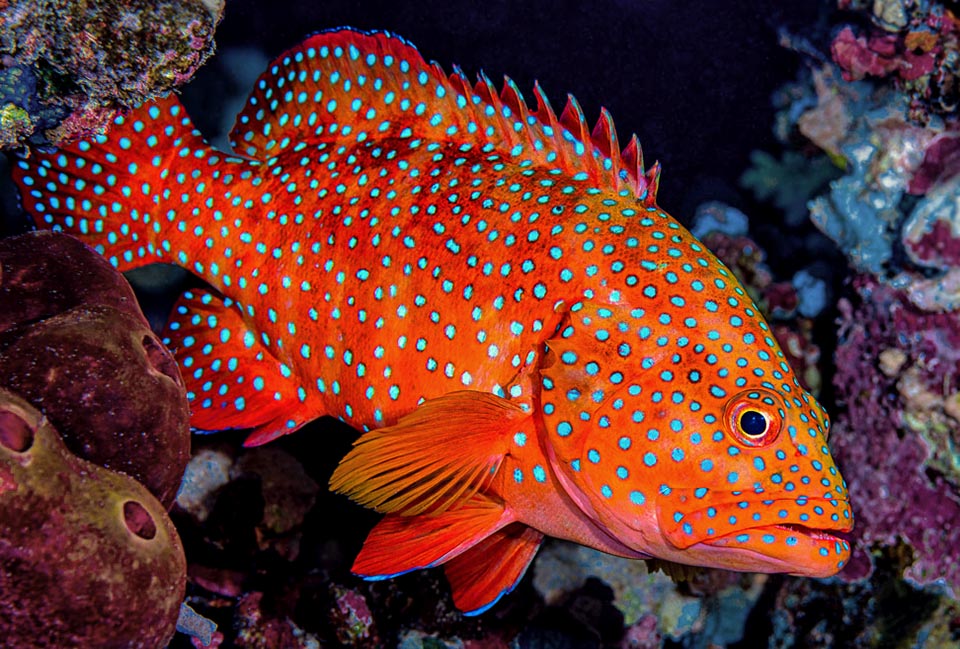
With its unmistakable red orange livery with blue spots livery, Cephalopholis miniata is a 40-50 cm is a grouper of the Indian Ocean and of Western Pacific © François Libert
The Coral hind (Cephalopholis miniata Forsskål, 1775) belongs to the class of Actinopterygii), the ray-finned fishes, to the order of Perciformes and to the family of Serranidae, which counts 75 genera and more than 500 species.
The etymology of the genus comes “kephale”, head, and “pholis”, scale, with reference to the fact that the fore part of the snout, up to the nostrils, has no scales.
The name of the species miniata, red coloured, in Latin, refers to the livery.
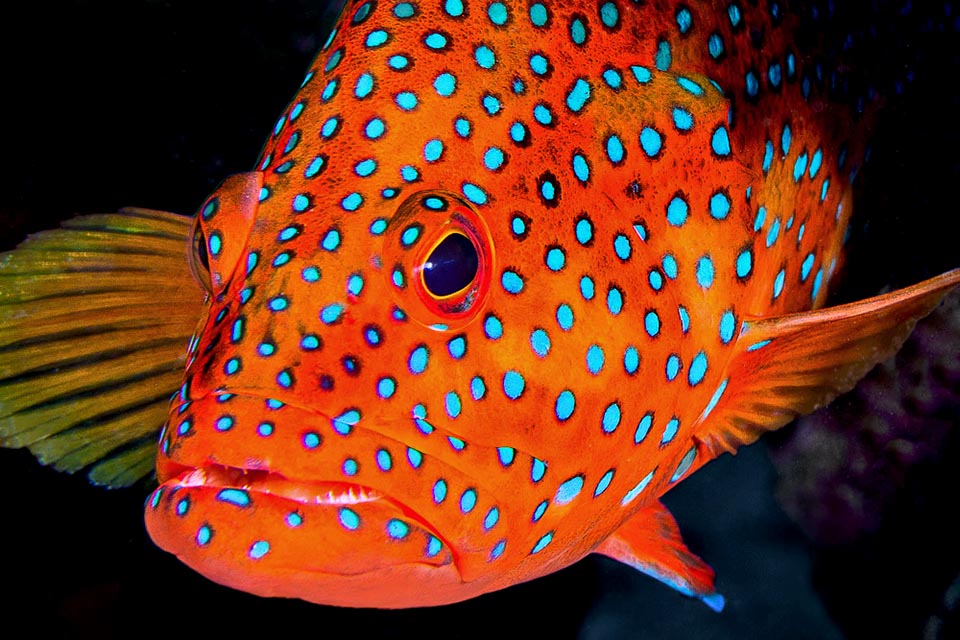
Conversely, these lively colours turn out to be mimetic in the corals colourful world, especially when swimming in deep waters, up to 150 m, where the red turns black © François Libert
Zoogeography
It has a vast distribution in the tropical waters of the Indian and Pacific oceans.
Indicatively, we find it from South Africa, Madagascar and Comoro Islands up to the Red Sea, the Seychelles, Mauritius, Réunion and Maldives, in India, Sri Lanka, Thailand, Malaysia, the Andaman Islands, in Australia, Indonesia, Micronesia, New Guinea, Palau, Philippines, Taiwan, China and the Ryukyu and Ogasawara Islands in the southern part of Japan. Eastward, it has colonized the Fiji Islands, Samoa, Tonga and Kiribati. Southwards, in the Pacific, it reaches the New Caledonia.
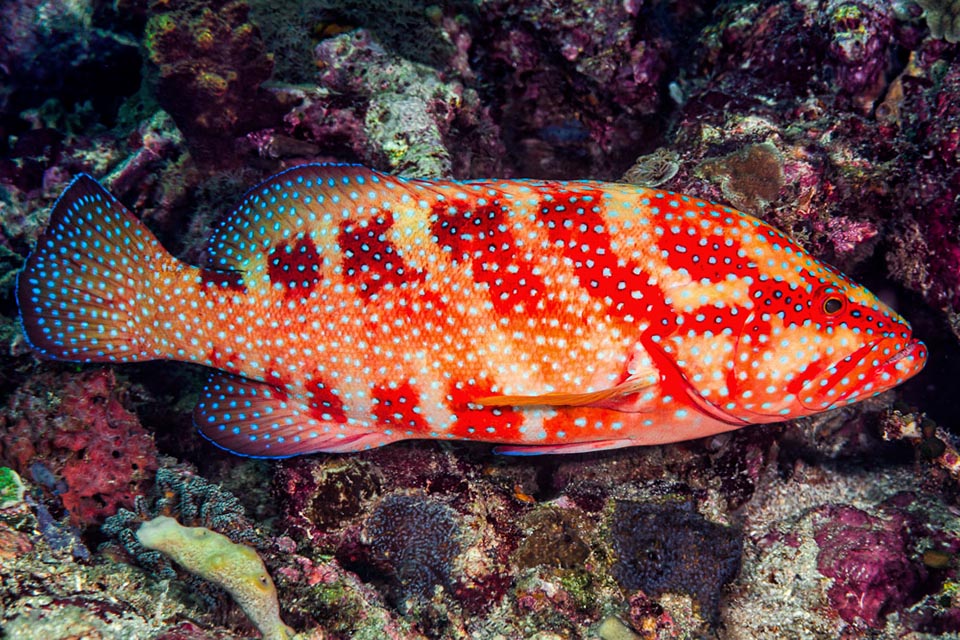
The livery is changeable and may be marbled or with vertical bands that break the outline for better surprising the prey, usually small fishes with a 20% of crustaceans © François Libert
Ecology-Habitat
It lives in the coralline formations, often on the outer side of the reefs, up to 150 m of depth.
Morpho-physiology
The coral hind may reach the 50 cm, but rarely exceeds the 40 cm. Slender, it has the characteristic look of the serranids, with the lower jaw longer and great mouth armed by various rows of teeth, with hooked and caniniform elements, on the fore part, in order to hold the preys.
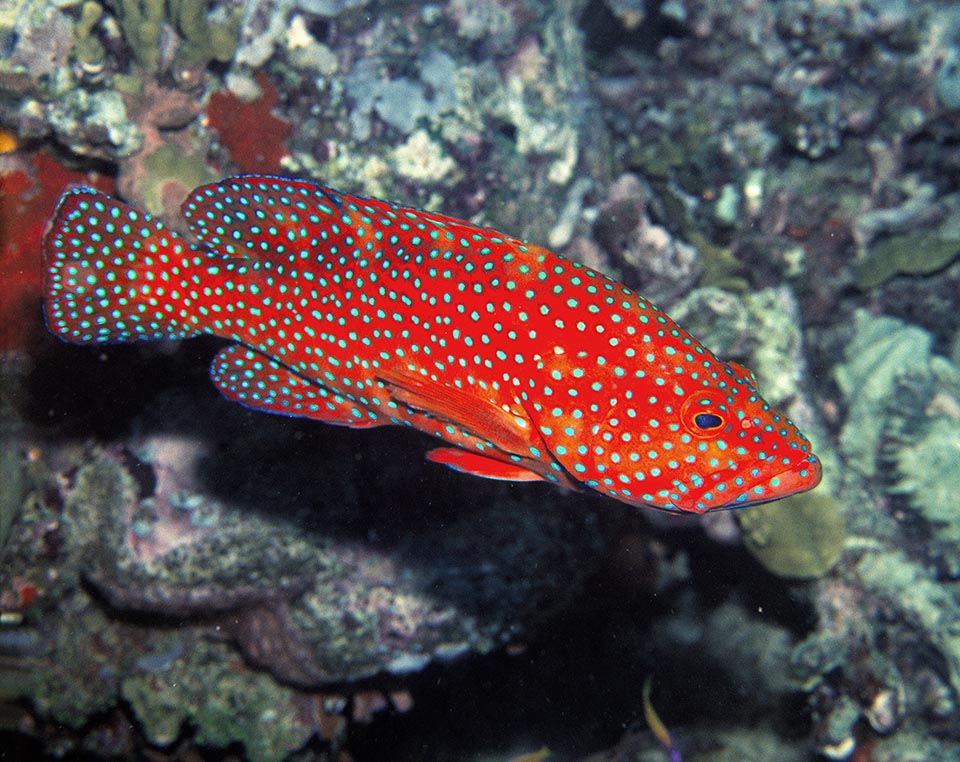
Known as Coral hind or Coral grouper, it is a territorial species, hermaphrodite proterogynous, that is with females that once reached a certain age may transform in males © Giuseppe Mazza
The dorsal fin counts 9 spiny rays and 14-15 soft ones; the anal 3 spiny rays and 8-9 unarmed; the ventral are modest, the tail is big and rounded, like the pectorals which have 17-18 unarmed rays. They are orange red, with sold colour, whilst the others and the whole body appear dotted by characteristic pale blue spots.
In the juveniles the background colour is yellow, whilst the oldest specimens, starting from the eight years, turn dark red.
Ethology-Reproductive Biology
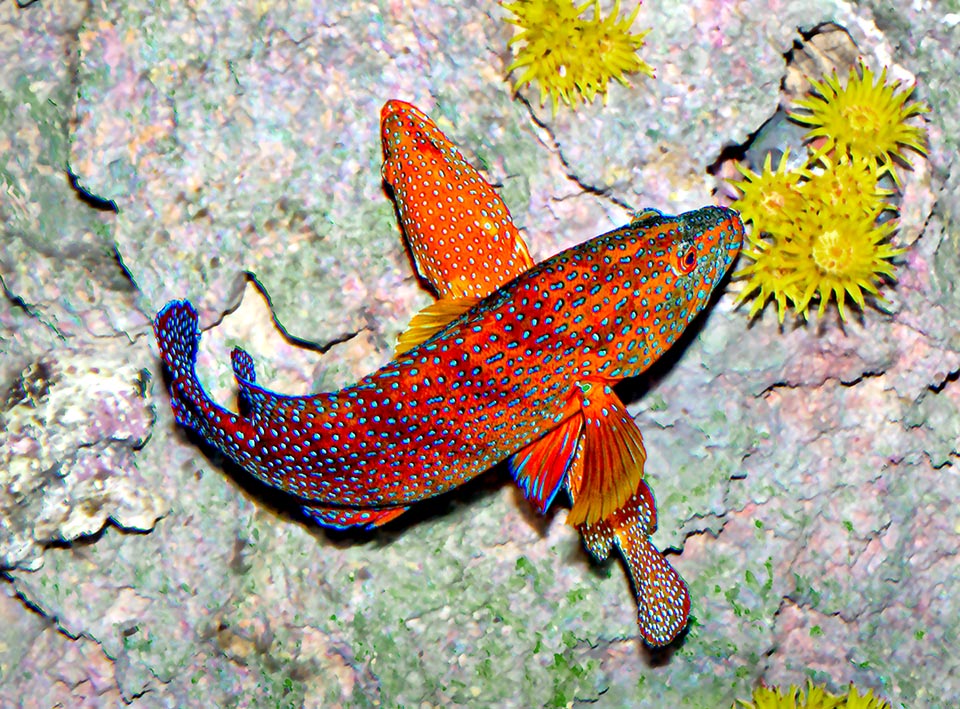
These control a territory with 2-12 females who are given a hunting area. For the reproduction they swim over the partner, fecundating thousands of 1 mm broad eggs © Giuseppe Mazza
The coral hind eats almost exclusively fishes, in particular the flaming Pseudanthias squamipinnis, a dozen of centimetres long, which twirl the whole day among the corals; but in the menu of this greedy predator enters also a good 20% of crustaceans and passing-by cephalopods.
The livery, extremely mimetic in full light in the colourful world of the reefs, is such also in deep waters where the red becomes black and the biggest specimens pounce, suddenly, on species of suitable size.
The Cephalopholis miniata is a decidedly territorial species, protogynous hermaphrodite, that is, with females who, once a certain size is reached, can become males.
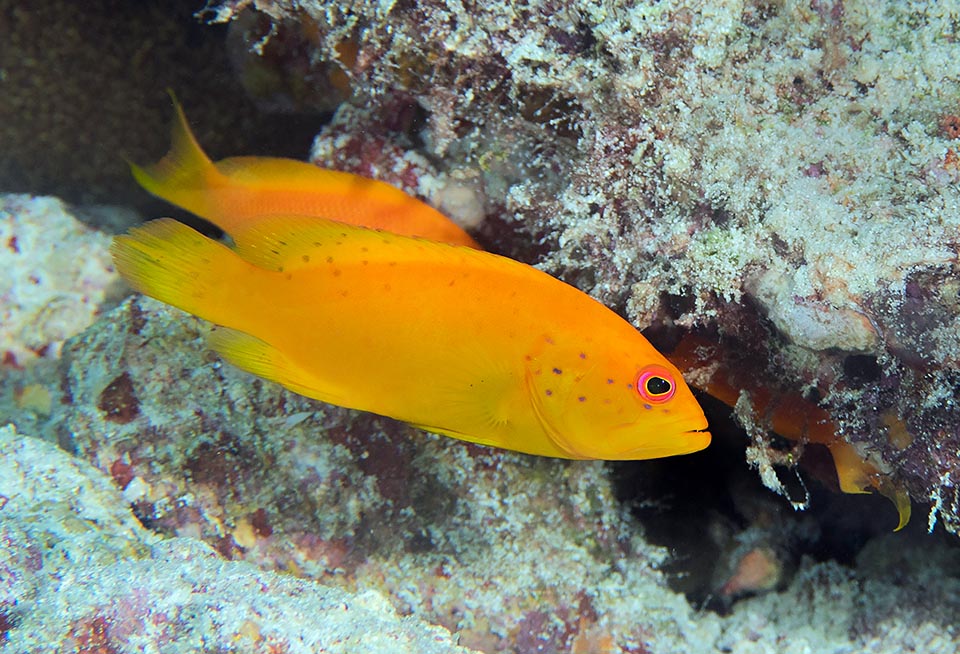
The 2 mm larvae are planktonic and only after two months they reach bottoms. Initially in juveniles the background colour is yellow with some dark small dot © Raf Amar
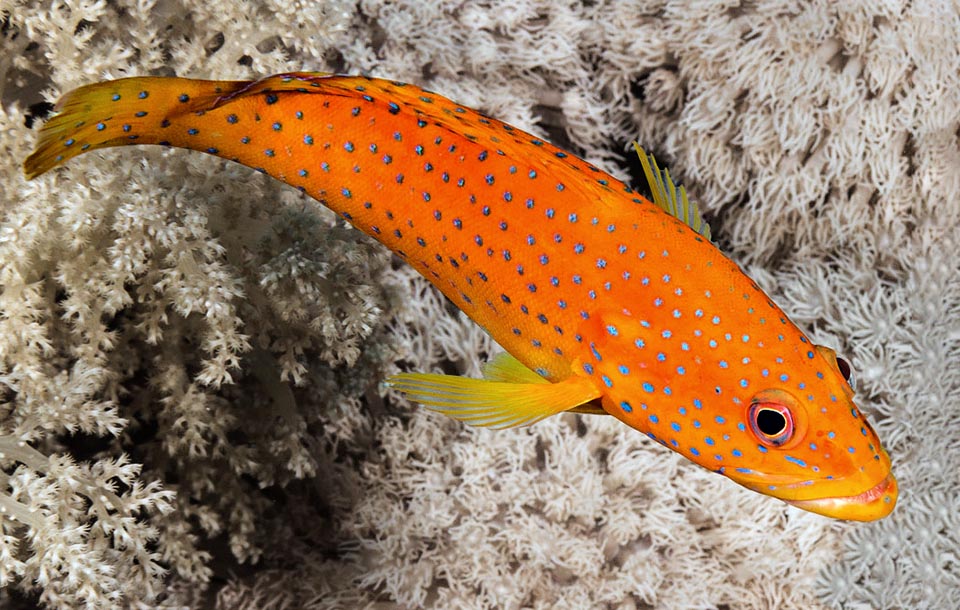
The subadults assume orange hues while the blue spots do appear. The growth is very slow and are needed 4,5-14 years for doubling the populations © François Libert
These ones control a more or less vast area, of about 500 m2, with a harem of 2-12 partners (exceptionally 20 in New Caledonia!), to whom they given following a precise hierarchy, personal hunting sectors.
The innumerable fecundated eggs are entrusted to the currents, but the growth is very slow and are needed 4,5-14 years for doubling the populations decimated by the events. In the IUCN Red List it is shown as “Least Concern”, that is at low risk of extinction, but apart from the aquarium market, if we add the divers’ hunting and that made for food purposes, the fishing vulnerability index marks already 65 on a scale of 100, almost like our Mediterranean Dusky grouper, Epinephelus marginatus, protected in various nations, like the Principality of Monaco, due to its sad record of 72 on 100.
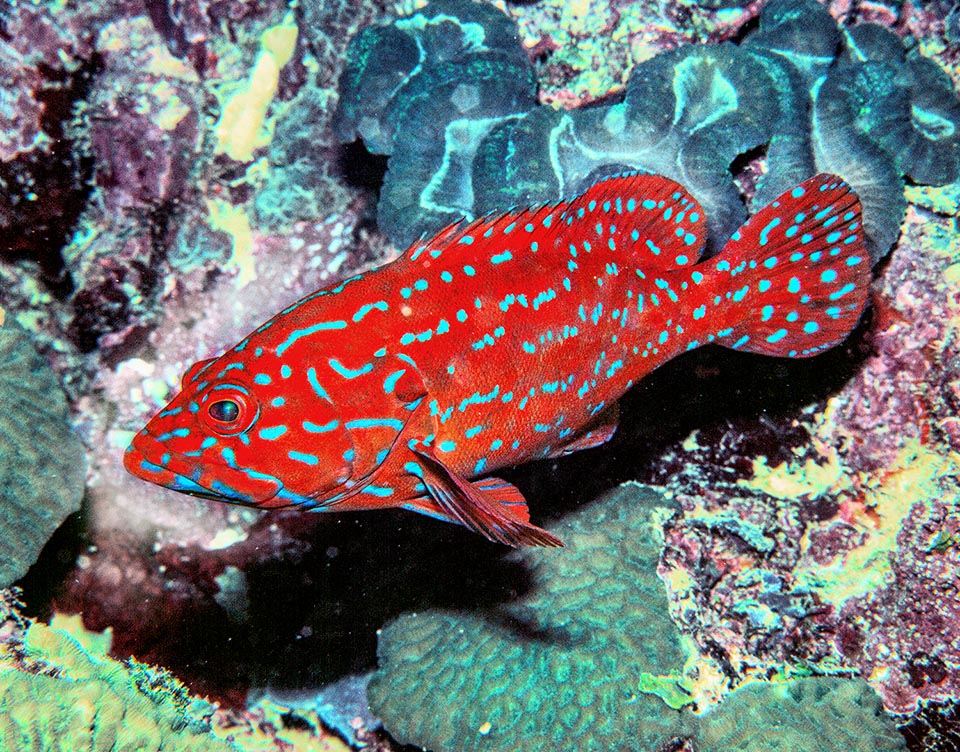
The fishing vulnerability index is high, already marking 65 on a scale of 100, and it’s a species to be surveyed even is it appears as “Least Concern” in the IUCN Red List © Giuseppe Mazza
Synonyms
Cephalopholis miniatus Forsskål, 1775; Cephalopolis miniatus Forsskål, 1775; Epinephelus miniatus Forsskål, 1775; Perca miniata Forsskål, 1775; Serranus miniatus Forsskål, 1775; Pomacentrus burdi Lacepède, 1802; Serranus cyanostigmatoides Bleeker, 1849; Cephalopholis maculates Seale & Bean, 1907; Cephalopholis formosanus Tanaka, 1911; Cephalopholis boninius Jordan & Thompson, 1914.
→ For general information about fishes please click here.
